Behold this prefect 30-minute Bami Goreng recipe. It will 100% blow your family away and and elevate your senses! Made with juicy seitan and crispy golden fried tofu, this dish is a heavenly plant-based classic Indonesian noodle dish that will leave thee doing happy-clappy. (That’s like when you are so happy, that you clap your hands, ok?).
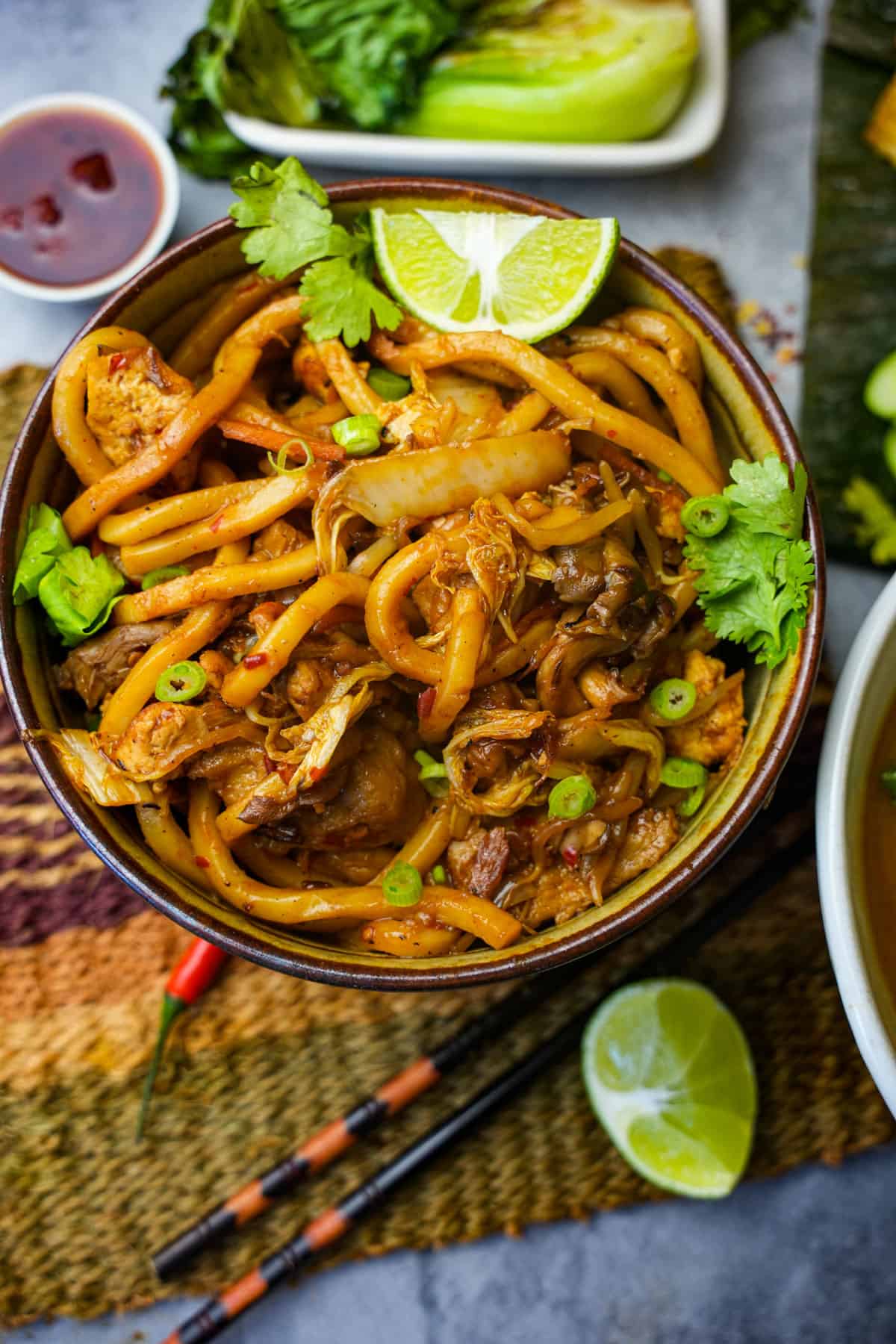
Serve it alongside my crispy rice dumplings, or top it with slices of homemade lontong, cooked in banana leaves. It's a great accompaniment to sayur lodeh, the classic Indonesian curry. If you have heard about nasi goreng, but NOT bami goreng, this is a problem, and today we are going to fix that!
This is the perfect combination of tender seitan, crispy fried tofu, and savory noodles, tossed in an aromatic blend of spices and vegetables, and it shall transport you to the streets of Southeast Asia where you will feel weak in the knees about the gosh darn flavor overload.
Fear not, for this divine dish requires simple ingredients and lightning-quick preparation, making it ideal for a weeknight dinner or meal prep. So, arise and join me in the celestial kitchen as we fire up the wok and rejoice by filling your whole bathtub to the brim with aromatic noodles to which you will want to bathe!
Jump to:
🥰Why you are going to adore the ever-loving heck outta this recipe
- 🏃♀️Quick and Easy: With simple ingredients and a preparation time of just 30 minutes, this meal is perfect for those who want to whip up a tasty dinner without spending hours in the kitchen. There is minimal cleanup, and the dish can be prepared from start to finish with just one pot if you hate washing dishes.
- 💪Vegan and Packed with Protein: This Bami Goreng recipe is completely vegan and made with wholesome ingredients, making it a healthy and guilt-free indulgence. Seitan and tofu are great sources of protein, while all the veggies provide essential vitamins and minerals.
- ✅Tested and Approved Worldwide: Like all the recipes on my blog, this bami has been meticulously fine-tuned not only by me but by a team of dedicated food enthusiasts around the world, including in Indonesia where the dish is from. No matter where you are on the planet, rest assured it's been tested to work everywhere!
🌶️Notable ingredients in this recipe

- Udon Noodles: Udon is a thick Japanese wheat noodle often used in stir-fry dishes. Many traditional recipes for Bami Goreng use egg noodles, but I hate to harm chickens, so I make the dish with udon noodles, which are also easy to come by. You can use 1lb. (0.45 kg.) of fresh udon noodles, or 8 oz. (226 grams) of dried udon which you will cook to use in the dish. If you can't get udon noodles, you can use thick rice noodles, or even spaghetti noodles to make this dish.
- Seitan: Seitan, also known as wheat meat or wheat gluten, is a meat substitute made from simmering wheat gluten in a flavorful broth, or steaming it. I have an incredible recipe you can follow for making the meatiest homemade seitan. If you cannot get seitan, you can substitute it with tempeh or drained canned young green jackfruit.
- Oyster Mushrooms (Jamur Tiram): Oyster mushrooms have a delicate texture and a mild flavor. They are a common ingredient in many Asian cuisines (you can even use 'em to make killer vegan shawarma) and can be found fresh or dried. If you cannot find fresh oyster mushrooms, you can substitute them with other types of mushrooms like shiitake, cremini, or boring old white button mushrooms.
- Kecap Manis: Kecap Manis is a thick, sweet soy sauce (almost like thin, dark Indonesian Teriyaki!) made from fermented soybeans or soy sauce and palm sugar. If you cannot find kecap manis, you can make your own easily! Follow my instructions for making homemade kecap manis which you can find in my mie goreng recipe.
- Sambal Oelek: Sambal Oelek is a hot-but-not THAT-hot chili sauce made from ground red chili peppers, vinegar, and salt. It is a common condiment in Indonesian cuisine and is often used to add heat and flavor to dishes like Bami Goreng. If you cannot find sambal oelek, substitute it with other hot red pepper sauces like Sriracha, or chili garlic sauce.
- Bean Sprouts (Tauge): Bean sprouts are a type of sprouted legume that are commonly used in Asian cuisine, including Bami Goreng. They have a crunchy texture and a slightly sweet, nutty flavor. If you cannot find bean sprouts, you can substitute them with other types of sprouts like alfalfa, mung bean or soybean sprouts.
See the recipe card for quantities and the complete ingredient list.
📖 How to make flawless bami goreng
You wanna see how these yummy noods get made? I will walk you through the whole process. Or you can follow along with the easy-to-print recipe card towards the bottom of this page.

Step 1
Mix the stir-fry sauce ingredients together using a tiny whisk or the tines of a fork and set aside.
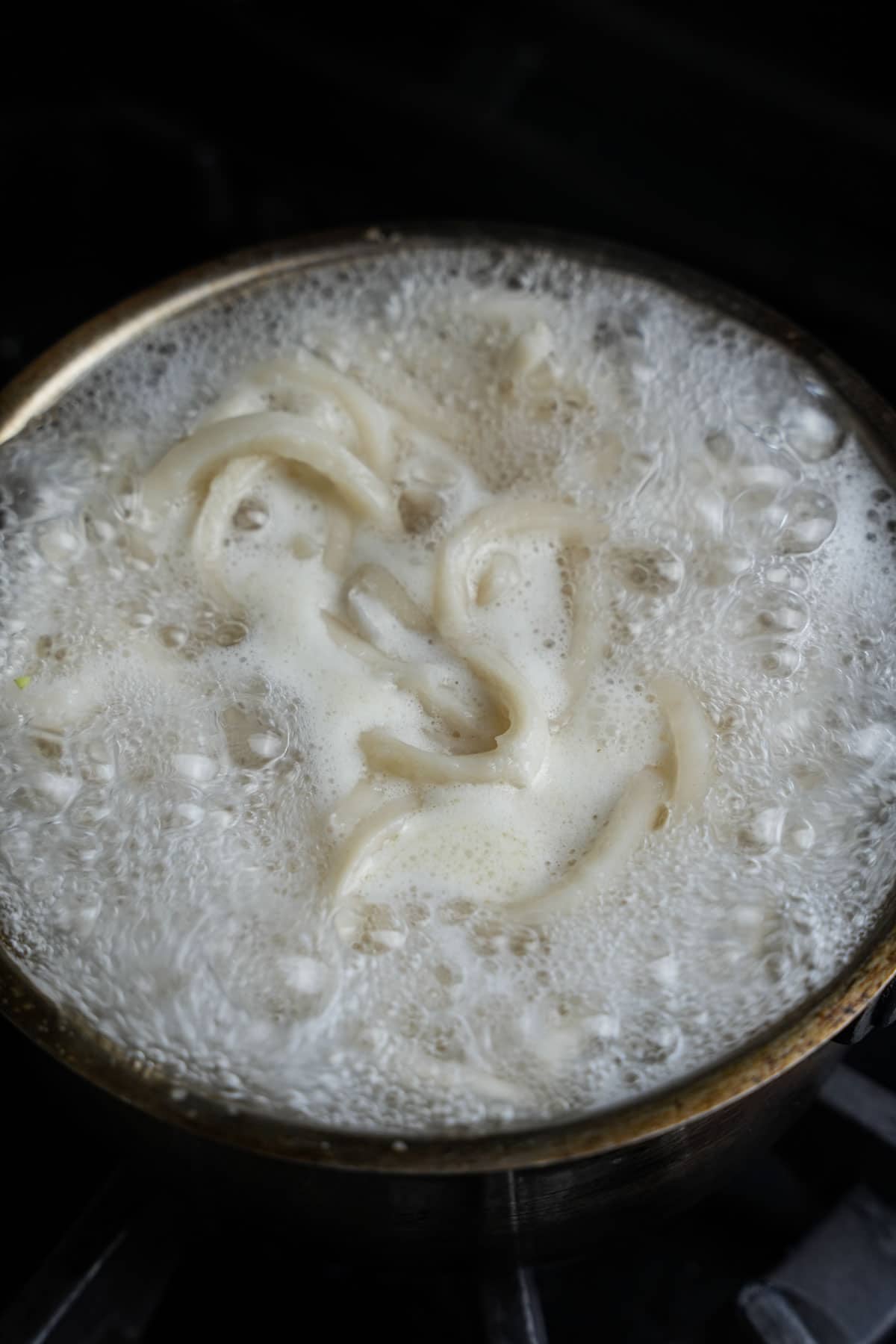
Step 2
Cook the udon noodles according to the package instructions until they are al dente. Once the noodles are cooked, drain them and rinse them with cold water to stop the cooking process.
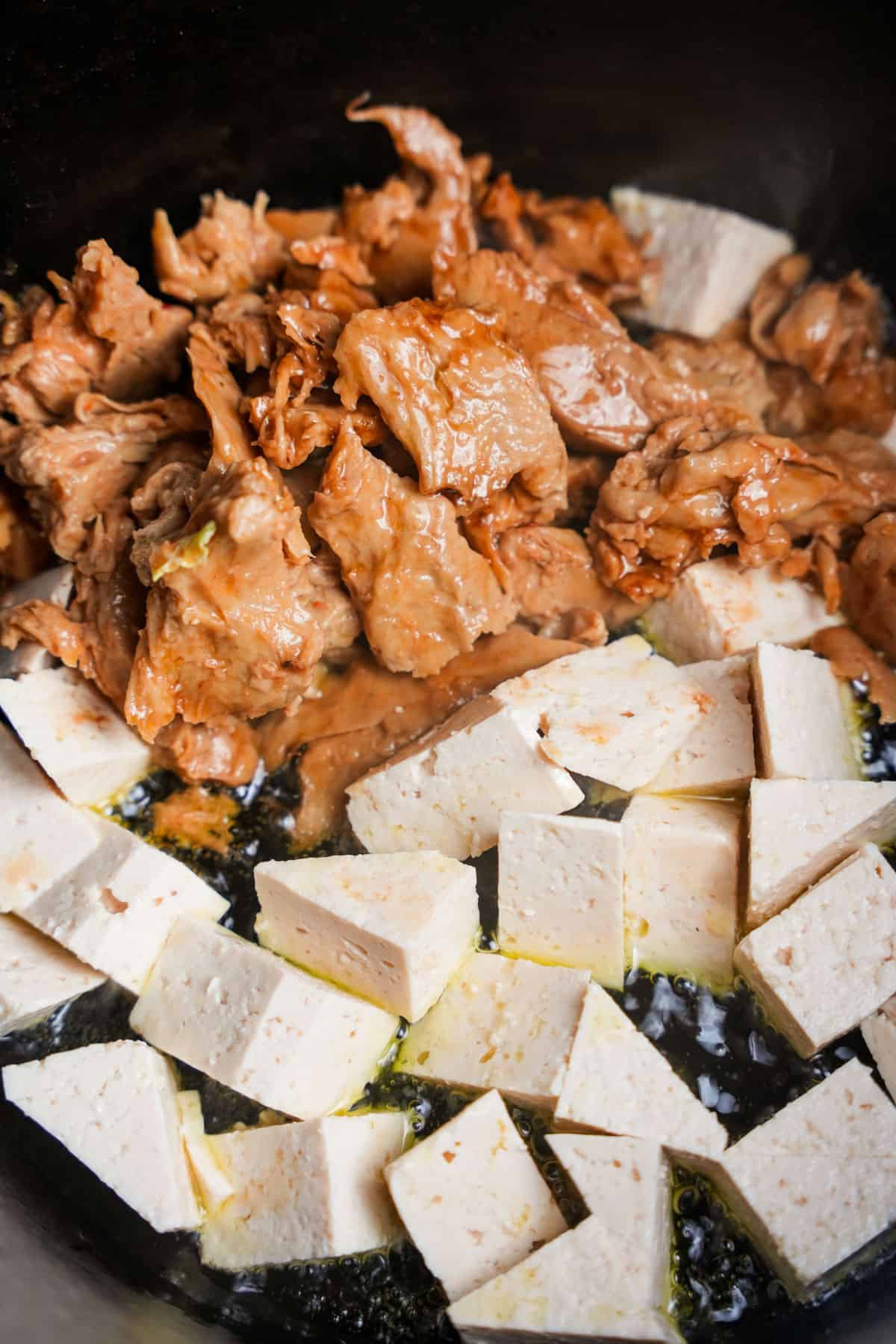
Step 3
Heat the canola, peanut, or vegetable oil over high heat in a wok or Dutch oven. Do not use toasted sesame oil, as the flavor will overwhelm this dish.
Add the extra firm tofu and torn seitan pieces to the wok and stir-fry for 7-8 minutes or until they are lightly browned all over.

Step 4
Once cooked, remove the tofu and seitan from the wok and set them aside, leaving the hot oil in the pan.

Step 5
Lower the flame to medium in the same wok and add the diced yellow onion and roughly chopped oyster mushrooms. Stir-fry for 2-3 minutes or until they are fragrant and softened.
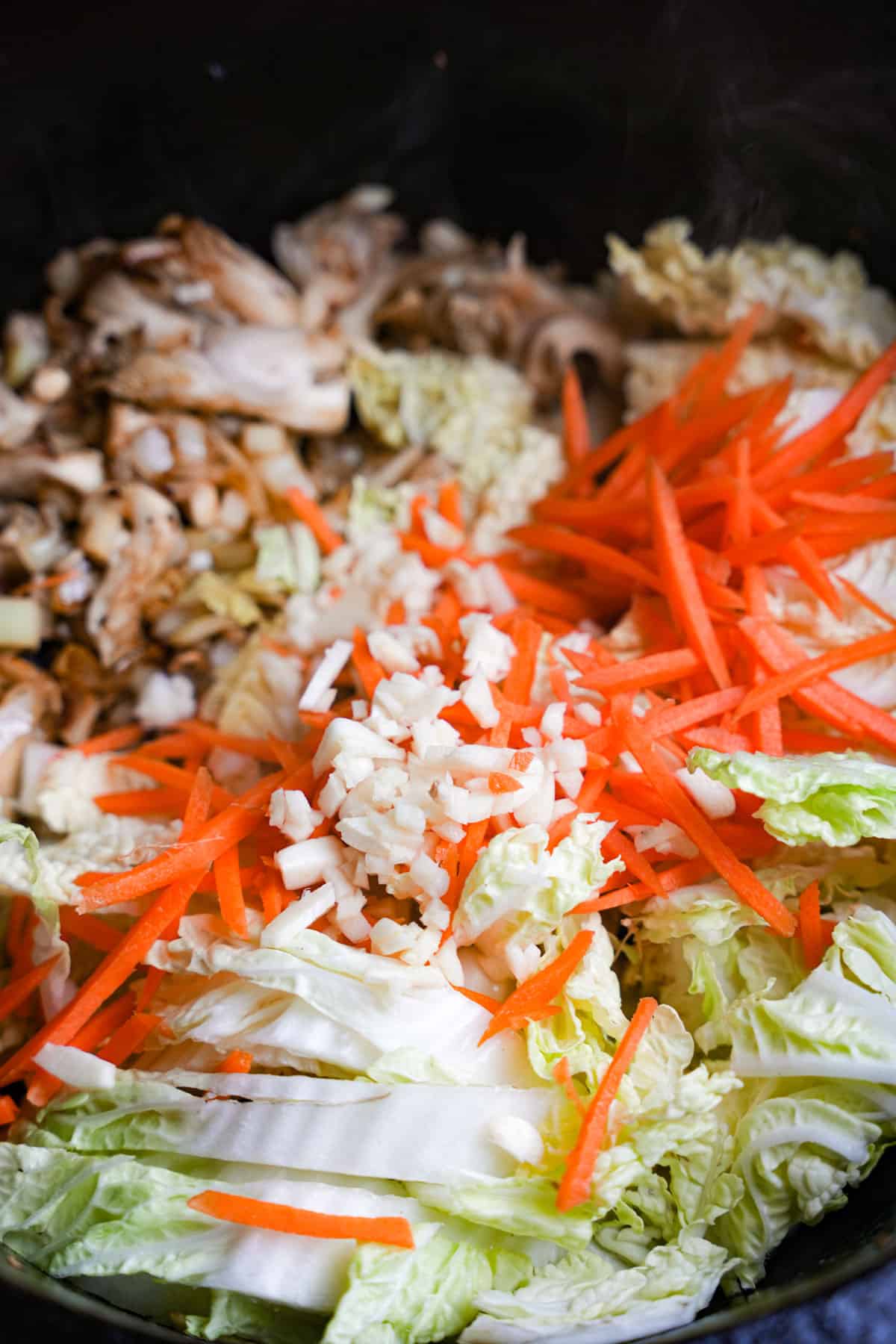
Step 6
Next, add the minced garlic cloves, chopped napa cabbage, and julienne-cut carrot to the wok and stir-fry for another 2-3 minutes or until they are slightly softened.
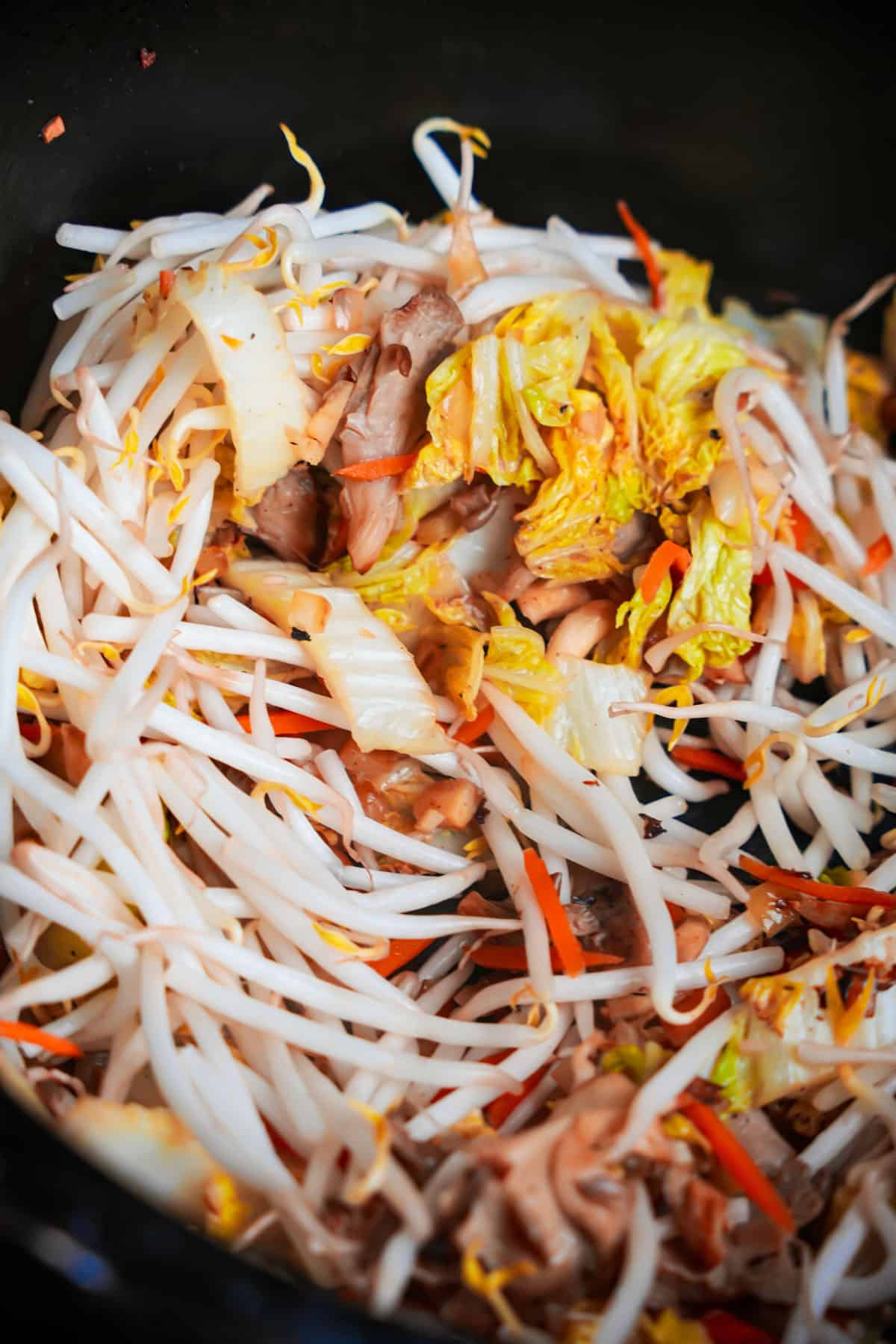
Step 7
Add the bean sprouts to the wok and stir-fry for another minute or until they are slightly softened.
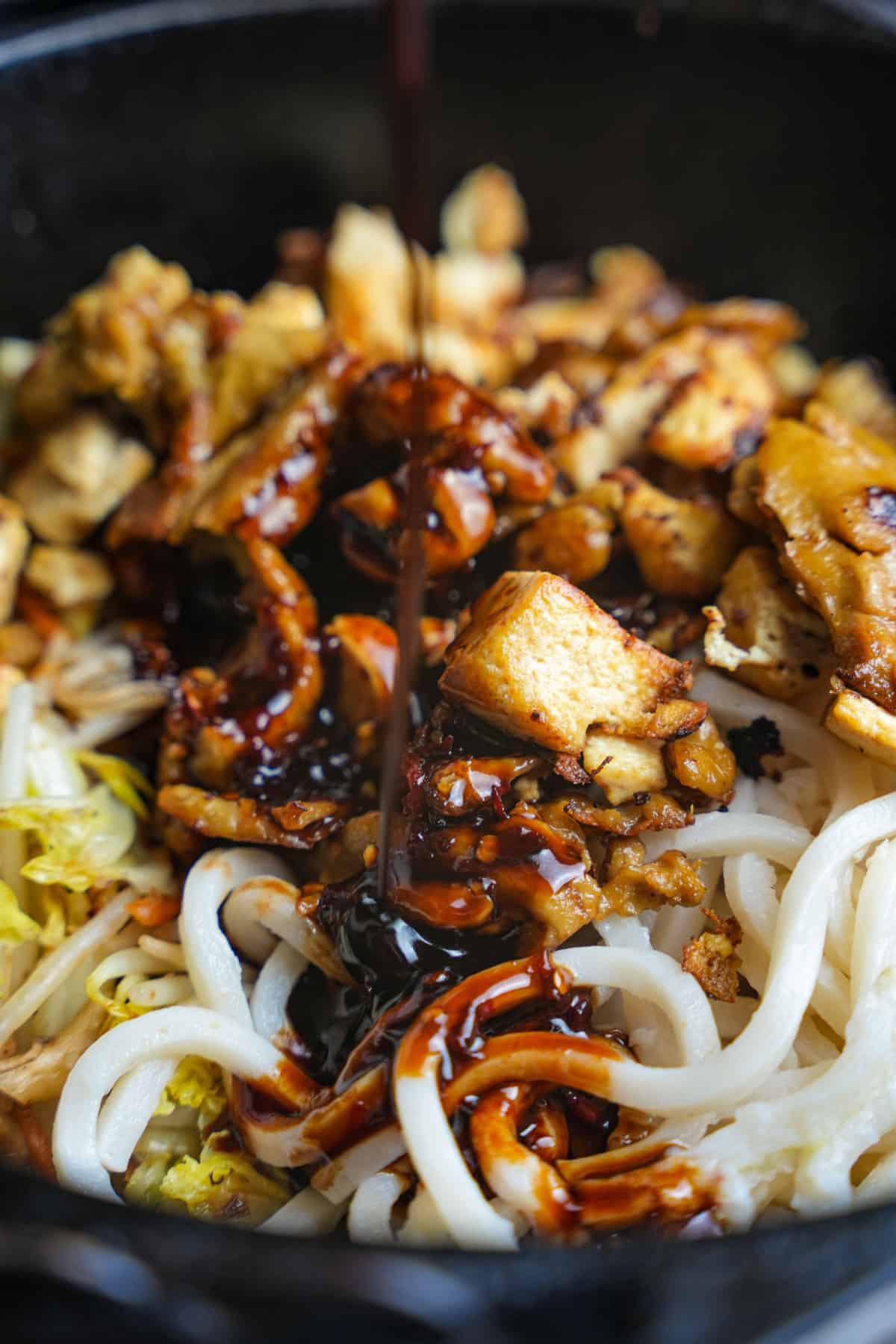
Step 8
Pour in the stir-fry sauce which includes tamari or soy sauce, kecap manis, vegan oyster sauce, and sambal oelek, and mix well with the vegetables and tofu/seitan.
Add the cooked udon noodles to the wok and toss together with the vegetables and sauce.
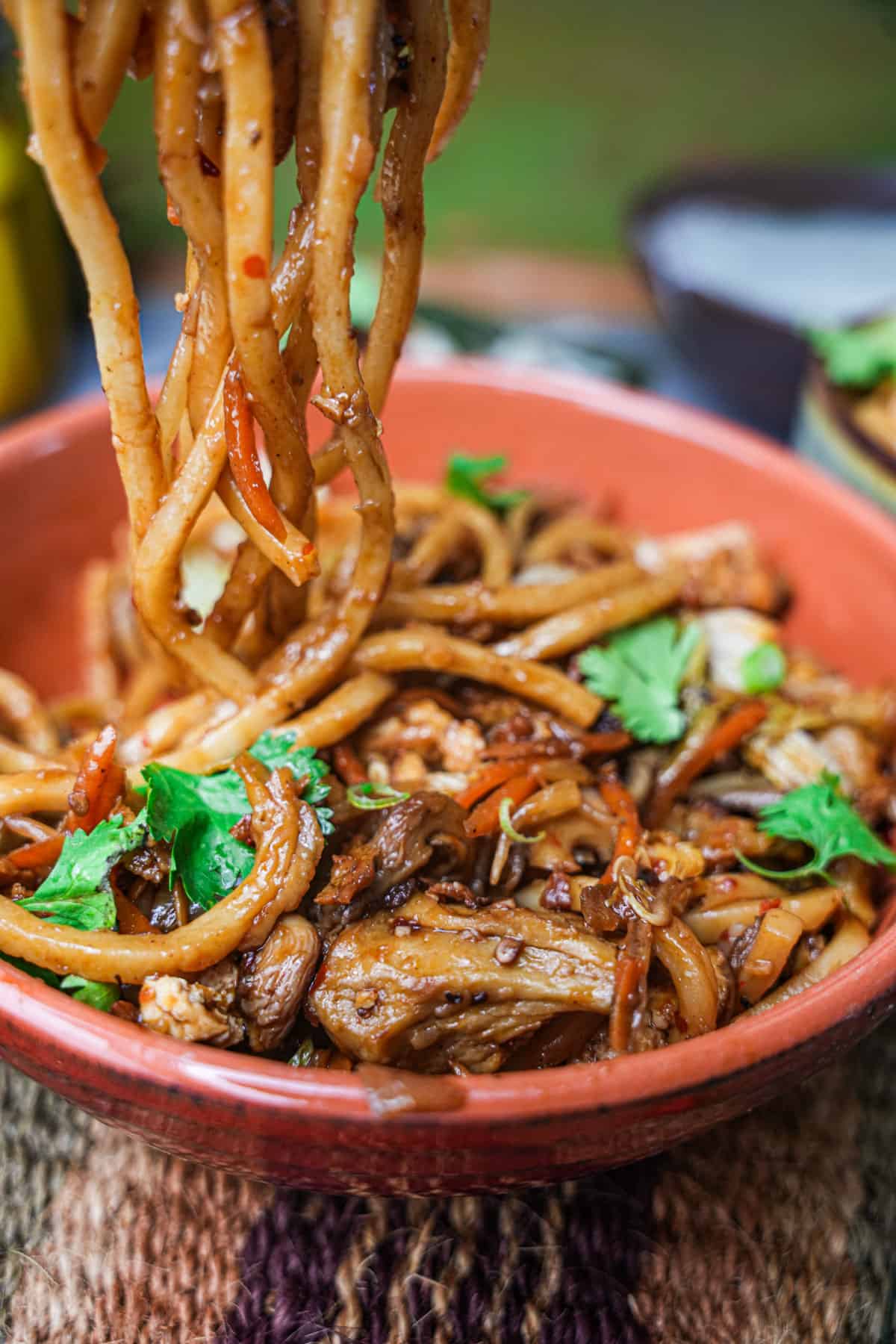
Step 9
Once everything is well mixed, serve hot and garnish with sliced spring onions, chopped peanuts, cilantro leaves, sambal oelek, and lime wedges, as desired. You can also drizzle it with homemade nuoc mam or even tom yum for extra heat and flavor.
💡Serving Ideas
While Bami Goreng is a true knockout on its own, it also goes together beautifully with so many other dishes!
Consider adding some pickled green chilies, pickled burdock, or spicy Korean cucumbers to bring some fresh contrast to the cooked noodles. Some nice appetizers to serve beforehand are Ketoprak, banh trang tron, chee cheong fun, crispy rice dumplings, or some smokey ensaladang talong.
Top off these noodles with sambal goreng tempeh, tofu katsu, miso glazed eggplant, or seitan bulgogi, dripping with Korean bbq sauce.
What are some good desserts to serve after?
Glad you asked!
Condidder serving an Indonesian street food classic like pandan crepes filled with coconut, Martaback Manis stuffed with chocolate and roasted peanuts.
If you would like a lighter Asian dessert to follow these thick noodles, consider checking out Vietnamese Flan, or Che Ba Mau.

👉Top tips
- Cook the noodles until they are just al dente, as overcooked noodles can become mushy when stir-fried.
- Make sure to thoroughly drain the cooked noodles and rinse them with cold water to stop the cooking process and prevent them from sticking together.
- Adjust the amount of sambal oelek and other seasonings to your taste preference, as some people may find it too spicy or salty.
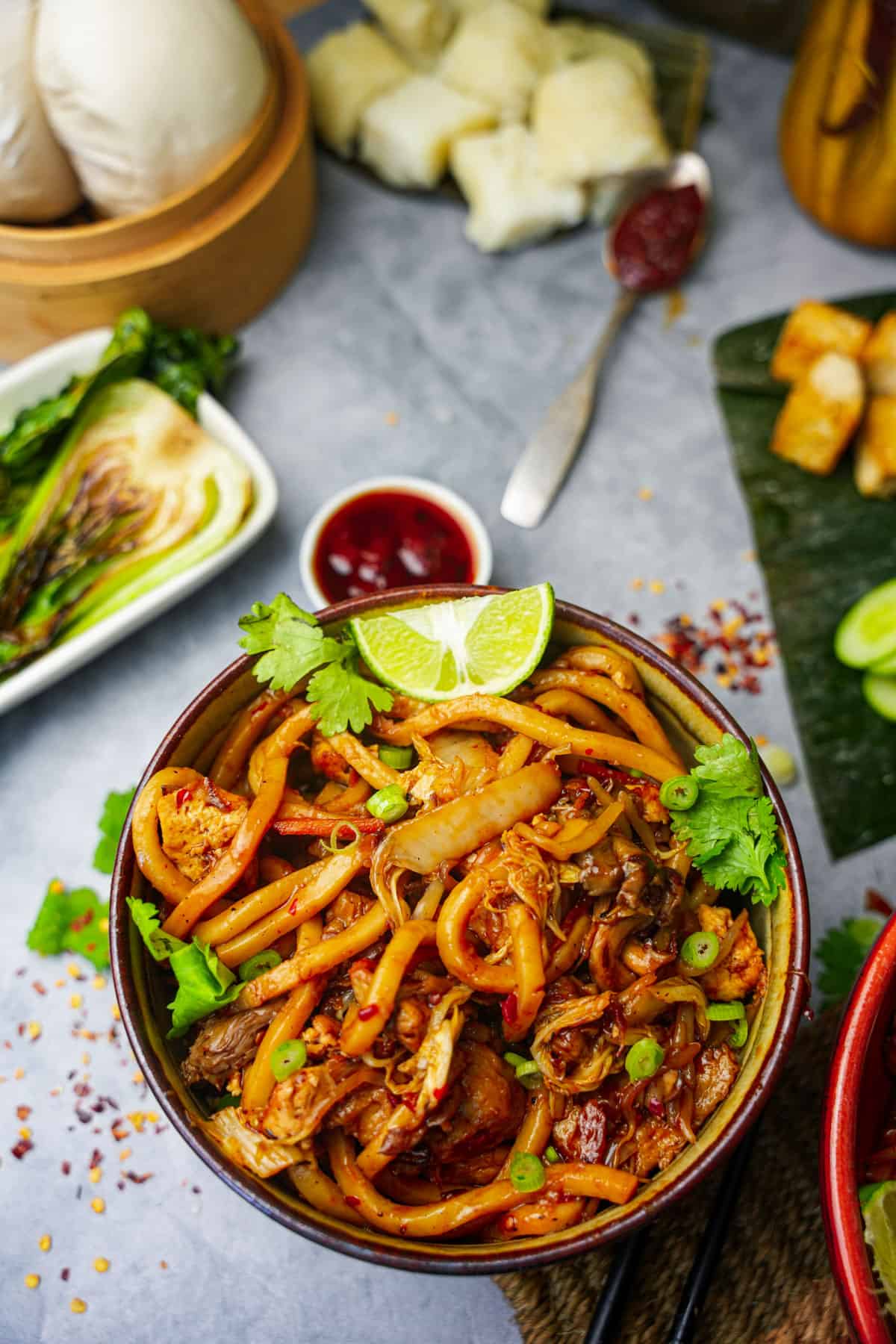
🤷♀️FAQ
Bami Goreng and Mie Goreng (or Mee Goreng) are Indonesian dishes popular in many parts of Southeast Asia. The main difference between the two is the type of noodles used.
Mie Goreng is a stir-fried noodle dish made with thin, yellow noodles called "mie" in Indonesian. These noodles are made from wheat flour and egg and have a slightly chewy texture. Mie Goreng typically includes a variety of vegetables, meat, and spices, and it is often served with a fried egg on top.
On the other hand, Bami Goreng is made with thicker, round noodles called "bami." These noodles are typically made from wheat flour, egg, and water and have a slightly softer texture than mie noodles. Bami Goreng also usually includes vegetables, meat, and spices but may sometimes include additional ingredients like shrimp or tofu.
So, the main difference between Bami Goreng and Mie Goreng is the type of noodles that are used. Mie Goreng is made with thin, yellow noodles, while Bami Goreng is made with thicker, round noodles.
Bami Goreng is a popular Indonesian dish that originated in the Dutch East Indies, which is now modern-day Indonesia. The dish is made of stir-fried noodles, vegetables, and sometimes meat, and is typically served with a variety of condiments such as sambal, soy sauce, and lime wedges.
Bami Goreng's origins can be traced back to the Chinese noodle dish called Chow Mein, which was brought to Indonesia by Chinese immigrants during the colonial period. The dish was then adapted to suit Indonesian tastes and ingredients, such as adding kecap manis (sweet soy sauce) and sambal oelek (chili paste).
Ever since the Dutch colonial era, Bami Goreng has become a popular street food in Indonesia and is sold by street vendors in bustling cities like Jakarta and Surabaya. Some vendors who serve the dish also serve mie goreng, which is practically the same dish made with thinner noodles.
"I need a fridge for my wrist, my ice game too cold." - A$AP Rocky
“Uh, speaking of that, here’s how to chill and reheat your noodles” - ADAM $OBEL
❄️Refrigeration
Let the bami goreng cool down to room temperature.
Transfer it to an airtight container or cover the wok with a lid and refrigerate within one hour of cooking.
Bami goreng can be stored in the refrigerator for up to four days.
🔥Reheating on the stove top:
Take the bami goreng out of the refrigerator and transfer it to a non-stick pan or wok.
Add a splash of water or a tiny drizzle of oil to the pan to help reheat the dish without sticking.
Heat the pan on medium-high heat, stirring occasionally until the bami goreng is heated through and steam is visible.
When serving, apply fresh garnishes to add a spark of life back to the dish.
☢️Reheating in the microwave:
Take the bami goreng out of the refrigerator and remove the lid or plastic wrap.
Cover the container with a microwave-safe lid or a damp paper towel.
Microwave on high for 1-2 minutes, stirring halfway through until the dish is heated through.
💣 Bangin' dishes to smash with bami goreng:
Say Hi on Social! 👋
Follow me on Instagram & Facebook for more recipes.
❤️Love this recipe? It helps me out greatly if you leave a 5-star 🌟🌟🌟🌟🌟rating in the recipe card below and maybe even leave me a lovey-dovey comment too!

Bami Goreng (30-minute thick Indonesian noodles)
Equipment
Ingredients
Stir-fry sauce:
- 4 teaspoons tamari or soy sauce
- 3 tablespoons kecap manis
- 3 tablespoon vegan oyster sauce
- 4 teaspoons sambal oelek
- 1 tablespoon rice vinegar
The stir-fried noodles and veggies:
- 450 grams fresh udon noodles or 8 oz. (226 grams) dried udon noodles
- 3 tablespoons canola peanut or vegetable oil
- ½ lb extra firm tofu cut into small triangles
- 1 ½ cups torn pieces of seitan
- 1 medium yellow onion diced
- 1 cup oyster mushrooms roughly chopped
- 3 cloves garlic minced
- 2 cups chopped napa cabbage
- 1 medium carrot julienne cut or shredded
- 1 ½ cups bean sprouts
Optional garnishes:
- 2 scallions thinly sliced
- ⅓ cup chopped dry roasted peanuts
- Cilantro leaves
- Sambal oelek
- Lime wedges
Instructions
- Mix together the stir-fry sauce ingredients with the tines of a fork or a small whisk. While you are cooking the noodles.
- Cook udon noodles according to package instructions until al dente. Drain and rinse with cold water to stop the cooking process. Set aside.
- In a wok or Dutch oven, heat oil over high heat. Add tofu and seitan and stir-fry for 7-8 minutes until lightly browned all over. Remove from the wok using a slotted spoon or tongs and set aside.
- Lower the flame to medium under the same wok, add onion, and oyster mushrooms. Stir-fry for 2-3 minutes until fragrant and softened.
- Add garlic, napa cabbage, and carrot to the wok and stir-fry for another 2-3 minutes until slightly softened.
- Add bean sprouts to the wok and stir-fry for another minute until slightly softened.
- Pour in the stir-fry sauce and add the cooked udon noodles tofu and seitan. Stir fry together for 2 more minutes until heated thoroughly.
- Serve hot and garnish with sliced scallions, chopped peanuts, cilantro leaves, sambal oelek and lime wedges, as desired.
Notes
- Make sure to stir-fry the vegetables in the order listed in the ingredients to ensure even cooking.
- Don't overcook the vegetables, as they should be slightly crisp to add texture to the dish.
- Feel free to adjust the amount of sambal oelek to your preferred level of spiciness.










Kate D.
Soooooo delicious and quick! No leftovers here…. Be careful as you’re going to want to hog it all to yourself;)